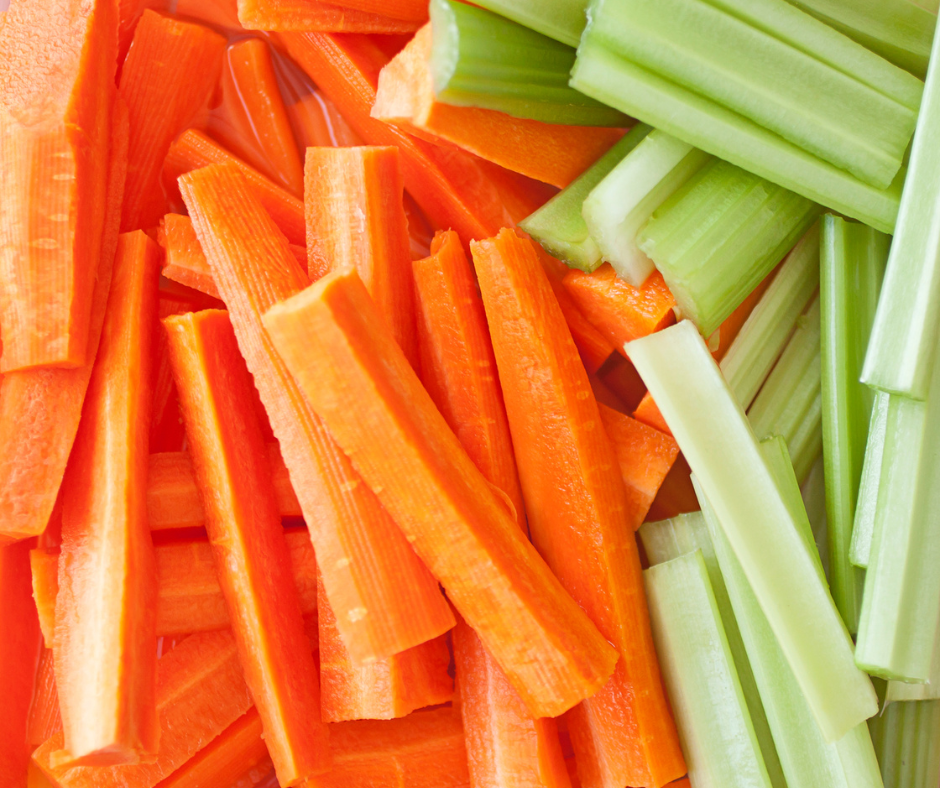Day 9
Carrot & Celery Sticks
The basics
This entry almost seemed too simple, too mundane to include. Carrots and celery? Really? Yes, really. Carrot and celery sticks are kid-favorite, mom-favorite snacks and just plain old family-snacking fun. My kids have grown up on them. And they’re a staple on the serving platter when my husband makes his popular, Danny’s Chicago Chicken Wings. So easy to prep and forget – they last for days in the fridge.
Carrots
You can get the pre-packaged baby carrots. However, I’m not a fan of those because they don’t seem to have as much crunch and freshness as the uncut and unprepped versions. So, I simply grab a 5-pound bag, organic of course, from the grocery store; wash a bunch at a time – scrub, scrub, scrub and use a potato peeler to get the outer skin layer off. I then cut off the tips on either end on a cutting board designated for fruits and veggies (very important to separate produce from poultry and meats to prevent cross contamination and illness).
Next, watch your fingers, and slice the carrot in half, horizontally, depending on the size. I use a butcher’s knife because it’s sturdy, and long and able to take on the width of any thick carrot. (If it is a smaller carrot, I proceed to the next step: the vertical cut.) Cut that half down the middle, vertically. Put the flat surface down on the cutting board and cut that in half. If the carrot has a lot of girth, I will cut vertically again. That takes care of the bottom half of the carrot. Repeat with the top chunk.
My mouth prefers thin manageable bites, so I cut them pretty narrowly. Plus the mom in me got accustomed to slicing things thin when my kids were little to prevent gagging on larger carrot chunks. So keep that in mind if you’re serving them to little ones. In general, I prefer taking smaller bites of food; I don’t enjoy big bits of anything. But you don’t have to cut them thin as I do; of course, cut them the way it works for you.
Now, if you follow my suggestion, you’ll have four sticks from the bottom half and four from the top half of each carrot. So, you’ll wind up with eight slices from one carrot for one average-sized carrot (or more if you also cut the quarter in half as I sometimes do. Remember, I like my sticks, and food, thin!).
Celery
Ah, stringy celery – a vegetable I did not care for in my childhood. The fibrous strings that run the length of a stalk. I wasn’t a fan; and I’m still not. The strings got caught in my throat more often than not. Not sure, but when the strings seem to dominate a piece of celery, it’s usually a drier stalk and bunch. So their prevalence may have to do with freshness and quality of the crop. These days, although we mainly buy organic produce, but not always, celery is the one vegetable I will only buy organic. Apparently, the pesticides in non-organic celery retain their potency more readily than in other non-organic produce, which can, of course, be detrimental to humans when consumed regularly. Not to give a plug to a grocery store chain that needs no plug from me, but far and away Whole Foods, at least here in SoCal, has the best, freshest, organic celery than any other grocer, specialty, organic, or otherwise that I’ve shopped..
When you bite into a piece of celery and it sounds like you’ve broken a brittle tree branch in half, you’ve got freshness in your mouth. You know you’ve found the right bunch when you observe the pale green color as you pluck it off the shelf and see plump-looking stalks (not thin-looking, limp twigs). Just eyeballing it tells you you’re going to get that characteristic crunch that makes eating the sometimes bland, mild-tasting vegetable a worthwhile endeavor.
The carrot and celery duo nutrient breakdown
We’ve all heard carrots are good for your vision. Carrots have beta carotene. Winchester Hospital notes that, “[the] body converts [beta carotene] into vitamin A , and vitamin A is important for healthy eyesight. Cleveland Clinic explains that carrots can help reduce the risk of cancer, including breast cancer because the root vegetable contains carotenoids. “Carotenoids, micronutrients in fruits and vegetables, may reduce breast cancer risk,” according to the NIH. Carrots also contain Vitamin B, C, D, E, and K, among others. Minerals include potassium, calcium, phosphorus, magnesium, and more. Celery is also a significant source of calcium, potassium, magnesium, vitamin A and beta carotene.
The Economic Times article, “Eating Celery, Carrots Regularly May Reduce Air Pollution Toxins in the Body,” says it all with just its article title. And, as we discussed on an earlier episode of my cleanse adventure, the best way to enjoy carrots and celery during a cleanse, in my opinion, is with almond butter!
Day 9 2024 – Carrot & Celery Sticks
María Felicia’s 2023 New Year Body… Cleanse – Day 9

Written by Maria Felicia Kelley
Disclaimer: Maria Felicia Kelley is not a medical doctor. The cleanse and fasting benefits she discusses in this post are derived from her own experiences and observations. Individuals should consult their own healthcare providers when eliminating foods from their diets.
@thenorthcountymoms | @1MariaFelicia
The North County Moms


